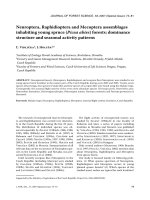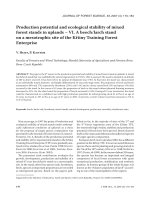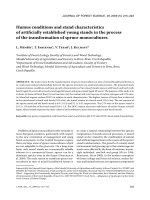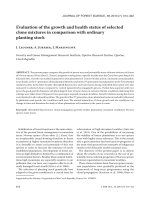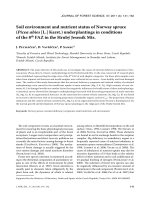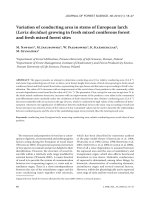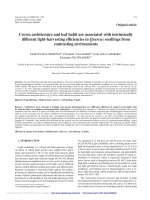Báo cáo lâm nghiệp: " Pointer years and growth in Turkey oak (Quercus cerris L) in Latium (central Italy). A dendroclimatic approach" docx
Bạn đang xem bản rút gọn của tài liệu. Xem và tải ngay bản đầy đủ của tài liệu tại đây (843.69 KB, 14 trang )
Original
article
Pointer
years
and
growth
in
Turkey
oak
(Quercus
cerris
L)
in
Latium
(central
Italy).
A
dendroclimatic
approach
M
Romagnoli,
G
Codipietro
Dipartimento
di
Scienze
dell’Ambiente
Forestale
e
delle
sue
Risorse,
Universitá
della
Tuscia,
01100
Viterbo,
Italy
(Received
2
November
1994;
accepted
1
November
1995)
Summary —
A
dendrochronological
and
a
dendroclimatological
analysis
was
carried
out
on
samples
of
Turkey
oak
from
seven
sites
in
Latium.
This
research
was
effected
in
order
to
investigate
what
cli-
matic
impulse
makes
the
dendrochronological
curves
of different sites
comparable
to
each
other.
The
Latium
region
proved
particularly
suitable
for
this
kind
of
analysis
due
to
its
many
orographic,
climatic
and
pedologic
differences
within
distances
of
a
few
kilometres.
Pointer
years
were
checked
on
the
resid-
uals
curves
and
on
the
raw
data
taking
into
account
the
same
growth
trend
for
consecutive
years.
The
dendroclimatic
analysis
showed
that
the
majority
of
pointer
years
are
related
to
spring
precipita-
tion
and
to
June
temperature.
In
addition,
a
preliminary
approach
is
reported
to
define
some
anatom-
ical
features
of
pointer
years.
An
automatic
image
analysis
system
was
used
to
examine
anatomical
features
in
pointer
years
and
a
new
method
for
histological
quantitative
representation
is
proposed.
dendroclimatology
/
Quercus
cerris /pointer
year
/
image
analysis
Résumé —
Années
caractéristiques
et
accroissement
du
chêne
chevelu
(Quercus
cerris
L)
dans
le
Latium
(Italie
centrale).
Une
approche
dendroclimatique.
Une
analyse
dendrochronologique
et
dendroclimatologique
a
été
menée
sur
quelques
échantillons
de
Quercus
cerris
prélevés
dans
sept
sites
du
Latium.
L’objectif
majeur
de
l’analyse
est
d’identifier
les
facteurs
climatiques
qui
rendent
com-
parables
entre
elles
les
courbes
dendrochronologiques
correspondant
aux
différents sites
prospectés.
La
région
prospectée
fournit
des
situations
orographiques,
pédologiques
et
climatiques
variables
sur
de
courtes
distances.
Les
années
caractéristiques
sont
déterminées
par
l’analyse
des
tendances
de
croissances
communes.
Il
résulte
de
l’analyse
dendroclimatique
que
la
plupart
des
années
caracté-
ristiques
sont
en
relation
directe
avec
les
précipitations
de
printemps
et
en
relation
inverse
avec
les
tem-
pératures
de
juin.
Par
ailleurs,
un
premier
essai
de
caractérisation
anatomique
des
années
ca-
ractéristiques
par analyse
d’image
a
été
réalisé
et
une
nouvelle
méthode
de
description
histologique
quantitative
a
été
testée.
dendroclimatologie
/Quercus
cerris
/ année
caractéristique
/ analyse
d’image
INTRODUCTION
Among
the
deciduous
Quercus,
the
species
robur,
petraea
and
pubescens
are
the
most
studied
from
a
dendrochronological
point
of
view.
Numerous
publications
are
available
concerning
the
dendrochronology
of
Quer-
cus
robur and
Q
petraea
(see
inter
alia
Pilcher
et
al,
1977,
1984)
and
the
dendro-
climatology
of
Q
robur,
Q
petraea
and
Q
pubescens
(cf
Pilcher
and
Gray,
1982;
Tessier,
1986;
Bednarz and
Ptak,
1990).
Many
dendrochronological
curves
have
been
established
for
both
dating
purposes
and
also
for
regional
and
more
expanded
interests.
Some
of
the
curves
range
back
over
many
centuries
because
of
the innate
durability
of
these
species
(Pilcher
et
al,
1977, 1984).
However,
in
just
the
past
few
years,
den-
drochronological
analysis
has
been
effected
in
Italy
on
Q
cerris,
an
oak
belonging
to
the
taxonomic
section
cerris
(Schirone
and
Romagnoli,
1990;
Romagnoli,
1993;
Corona
et
al,
1994;
Martinelli
et
al,
1994).
The
species
range
is
limited
to
central
southern
Europe,
but
it
is
present
particularly
in
the
Italian
and
Balcanic
Peninsula
and
it
may
also
be
found
in
central
East
Asia.
From
an
anatomical
point
of
view,
Q
cerris
is
a
porous
ring
species
and,
like
other
species
belong-
ing
to
the
cerris
section,
it
shows
gradual
transition
from
earlywood
to
latewood.
Ves-
sel
diameter
is
larger
than
that
measured
in
the
suber
taxonomic
section.
Latewood
vessel
frequency
is
less
than
that
in
the
sec-
tion
robur
species.
From
a
dendroclimatological
viewpoint,
some
results
relative
to
the
same
species
were
previously
obtained
in
Syria
(Chalabi
and
Serre-Bachet,
1981)
and
articles
deal-
ing
with
the
same
subject
have
been
pub-
lished
by
Janous
and
Bartak
(1991),
Jaro
and
Tatraaljai
(1984),
Babos
(1986)
and
Raev
and
Georgiev
(1985)
in
the
Balcanic
region.
Currently,
the
dendrochronological
curves
of
Turkey
oak
in
Italy
span
only
one
or
two
centuries
with
the
exception
of
some
spec-
imens
found
in
Sicily.
This
can
be
attributed
to
either
Italian
forestry
activities,
meaning
that
Turkey
oak,
often
found
in
coppice
stands,
is
frequently
subjected
to
cutting,
or
to
poor
durability
of
the
species
(Corona,
1988, 1989).
Deciduous
oaks,
Turkey
oak
included,
are
sensitive
to
the
environment
and
are
characterized
by
homogeneous
den-
drochronological
behaviour
covering
large
areas.
Thus,
they
record
the
same
climatic
impulse
at
different
latitudes
(Corona,
1987,
1989)
and
in
different
ecological
circum-
stances.
This
characteristic
initiated
the
search
for
those
common
climatic
factors
which
might
determine
the
common
behaviour
of
different
populations
of
the
same
species.
The
Latium
region
proved
particularly
suit-
able
for
this
kind
of
analysis
due
to
its
numerous
orographic,
climatic
and
pedo-
logic
differences
within
distances
of
a
few
kilometres.
MATERIALS
AND
METHODS
Study
area
Although
from
a
climatic
point
of
view,
the
Latium
region
(central
Italy)
is
characterized
by
Mediter-
ranean
rainfall
distribution
(ie,
minimum
rainfall
during
summer
months
and
maximum
during
autumn),
the
area
under
investigation
shows
vari-
able
drought
and
cold
stress
periods.
The
spec-
imens
stand
in
soils
which
have
different
degrees
of
fertility
and
depth.
Some
characteristics
of
the
evaluated
area
are
reported
in
table
I (for
further
details,
cf
Blasi,
1994).
Turkey
oak
is
the
most
common
deciduous
oak
found
in
the
landscape
we
studied.
It
grows
in
pure
or
mixed
stands
with
occasional
elements
of
Holm
oak
(Q
ilex)
and
cork-oak
woods
(Q
suber)
(sites
3,
4,
5,
6,
7)
but
most
often
with
pubescent
oak
(Q pubescens).
Where
water
table
surfaces,
Turkey
oak
can
be
found
mixed
with
British
oak
(Q
petraea).
Other
differences
between
sites
must
be
attributed
to
distance
from
the
sea
(cf
fig
1);
alti-
tude,
which
spans
from
close
to
sea
level
(sites
6
and
7)
to
100-500
m
asl
(sites
2,
3,
4,
5)
to
about
700
m
asl
in
site
1;
and
to
other
particular
micro-
climatic
circumstances
such
as
vicinity
to
a
lake
(sites
1
and
5).
Samples
Sixty-four
Turkey
oak
trees
were
analysed
(table
II).
Cores
and
disks
were
taken
at
breast
height
from
dominant
and
codominant
trees
in
high
forests
(sites
1, 5, 6, 7),
from
standards
in
coppice
(sites
3
and
4)
and
either
from
isolated
trees
or
from
trees
situated
in
marginal
positions
(site
2).
Tree-ring
data
Identification
of
the
common
climatic
factor
acting
on
tree
growth
was
effected
by
identifying
’pointer
years’ on
dendrochronological
curves
(Schwein-
gruber
et
al,
1990),
and
establishing
the
mean
of
tree
ring
to
climate
relationships
through
response
functions
(Tessier
and
Serre-Bachet,
1990).
In
addition,
an
image
analysis
approach
was
carried
out
to
investigate
whether
particular
microscopic
characteristics
such
as
vessel
dis-
tribution
(eg,
one
or
three
rows
of
vessels
forming
the
porous
ring
part)
corresponded
to
pointer
years
individuated
by
means
of
growth
trend
anal-
ysis.
Dendrochronological
curves
and
pointer
years
Ring
widths
were
measured
in
units
of
1/100
mm
and
the
dendrochronological
curves
for
each
core
were
developed
using
Aniol’s
system
(Aniol,
1983,
1987).
Mean
site
chronologies
were
formed
after
verifying
visual
and
statistical
synchronization
between
the
dendrochronological
curves
of
indi-
vidual
trees.
These
site
chronologies
were
then
averaged
to
obtain
a
preliminary
mean
regional
curve
for
the
area.
Each
individual
tree
curve
was
standardized
using
Arma
models
(Guiot,
1986).
The
order
of
the
Autoregressive
and
Moving
Aver-
age
model
is
determined
by
considering
auto-
correlation
in
series,
at
the
same
time
excluding
complicated
models
which
are
difficult
to
explain
from
the
biological
point
of
view
(Tessier,
1986;
Guiot,
1990;
Nola,
1992;
Corona
et
al,
1994).
These
procedures
result
in
residuals
without
auto-
correlation.
Hence,
seven
site
mean
curves
and
a
regional
mean
curve
of
the
residuals
were
established.
Pointer
years
were
checked
on
residual
curves
and
raw
data,
taking
75%
as
the
threshold
for
samples
having
the
same
growth
trend
for
con-
secutive
years
(Huber
and
Giertz-Siebenlist,
1969;
Trénard
and
Duchateau,
1985;
Nola,
1992).
Results
are
discussed
referring
to
pointer
years
based
on
75%
of
the
total
64
samples
and
begin-
ning
with
1921
as
the
initial
year
of
rainfall
obser-
vation
(table
II).
Although
the
common
growth
trend
among
trees
is
often
called
pointer
interval
(Schwein-
gruber
et
al,
1990),
for
the
purposes
of
this
research,
it
seems
more
appropriate
to
speak
generally
about
pointer
years
as
we
do
not
wish
to
restrict
the
meaning
of
the
present
paper
to
the
sole
analysis
of
annual
widths.
Image
analysis
Intra-annular
elements
(vessel
area
and
distri-
bution)
are
investigated
from
five
random
sam-
ples
collected
in
site
4,
characterized
by
chronolo-
gies
which
are
very
well
correlated
to
each
other
and
with
climatic
parameters
as
well.
We
exam-
ined
the
5
years
spanning
from
1950-1954
which
are
characterized
by
three
pointer
years
(1951,
1952
and
1953).
Microscopic
wood
sections
were
prepared
and
observed
using
a
stereomicroscope
with
a
video
camera.
The
picture
taken
by
the
camera,
which
corresponds
to
a
real
wooden
surface
of
about
7
mm
*
5
mm,
is
digitized
into
a
grid
of
pix-
els
which
are
displayed
on
the
computer
screen.
The
digitized
image
may
subsequently
be
stored.
The
automated
image-analysis
system
differ-
entiates
an
object
from
the
background
by
means
of
differences
in
levels
of
grey
relative
to
the
image
pixels.
The
image
analysers
scan
the
mem-
ory
for
pixel
data
having
intensity
values
greater
than
or
less
than
certain
threshold
value
set
by
the
user,
and
they
look
at
the
number
of
such
pixels,
recognizing
objects
by
selecting
out
groups
of
contiguous
pixels.
A
ring
and
an
intraradial
portion
is
delimited
in
each
image
(fig
2).
The
number
of
vessels
is
counted
and,
for
each
vessel,
lumen
area
and
the
coordinates
of
the
point
closest
to
the
ring
boundary
were
recorded
(fig
2,
raw
vessel
dia-
gram).
A
method
of
standardization
was
developed
so
as
to
compare
different
years,
which
have
differ-
ent
ring
widths,
and
to
simplify
the
representa-
tion of
vessel
distribution
down
to
ten
elements.
This
system
differs
from
that
usually
employed
to
obtain
tracheidograms
for
coniferous
trees
(Vaganov,
1990;
Codipietro,
1994).
It
consists
in
dividing
the
ring
into
ten
equal
segments
and
averaging
the
area
values
of
the
vessels
origi-
nating
in
the
same
interval
(fig
2,
vessel
dia-
gram).
The
standardized
vessel
diagram
shows
vessel
lumen
variation
within
the
ring
and
high-
lights
such
phenomena
as
stasis
in
the
forma-
tion
of
the
vessel
lumen.
The
standardized
series
of
the
five
samples
were
compared
using
mean
values
and
standard
deviation.
Climatic
data
Climatic
data
were
collected
by
the
’Annali
del
Servizio
ldrografico
del
Ministero
dei
Lavori
Pub-
blici’.
Monthly
precipitation,
total
annual
precipi-
tation,
monthly
maximum
and
minimum
temper-
ature
and
mean
annual
temperature
from
the
meteorological
stations
located
near
the
investi-
gated
sites
were
taken
into
account.
Some
mete-
orological
series
were,
however,
not
included
due
to
shortage
of
or
missing
data.
The
final
climatic
and
dendroclimatic
elaboration
was
carried
out
using
the
meteorological
series
which,
following
preliminary
dendroclimatic
analysis,
produced
the
best
results
correlating
with
the
den-
drochronological
data.
The
main
mean
meteorological
parameters
(rainfall
and
temperature)
of
weather
stations
employed
in
this
analysis
are
reported
in
table
II.
Monthly
temperature
and
precipitation
series
were
arranged
from
October
of
the
year
t-1
to
September
of
the
year
t
(year
of
ring
construc-
tion)
(Serre-Bachet
and
Loris,
1988;
Tessier,
1989;
Messaoudene,
1989;
Tessier
and
Serre-
Bachet,
1990;
Tessier
et
al,
1994)
for
the
period
of 1931-1985.
Monthly
precipitation
and
monthly
tempera-
ture
of
six
and
three
metereological
stations,
respectively,
were
averaged
to
obtain
an
array
of
data
which
may
be
considered
more
repre-
sentative
of
the
regional
climate
of
the
investi-
gated
area.
This
matrix
enables
us
to
obtain
bet-
ter
results
during
the
processes
of
calibration
and
verification
(Blasing
et
al,
1981)
and
in
calculating
the
response
function.
Monthly
precipitation
data
was
combined
with
monthly
maximum
tempera-
ture
and
monthly
minimum
temperature
data
in
order
to
form
two
arrays
of
24
regressors
(P-
TMAX,
P-TMIN)
for
each
meteorological
station
and
for
the
averaged
climatic
regional
parame-
ters.
Growth-climate
relationship
The
growth-climate
relationship
was
investigated
in
two
phases.
Pointer
years
marked
on
the
resid-
uals
total
mean
curve
were
compared
with
annual
mean
climatic
data
arranged
from
October
of
year
t1
to
September
of
year
t.
Subsequently,
a
response
function
was
calculated
using
the
global
array
of
climatic
data
as
an
independent
variable
and
the
mean
total
residual
curve
as
a
depen-
dent
variable.
A
response
function
for
each
site
was
also
calculated
using
each
residual
curve
as
a
dependent
variable
and
the
meteorological
series
of
stations
closest
to
the
site
examined
as
independent
variables.
The
response
functions
are
estimated
using
the
bootstrap
method.
This
methodology
was
established
by
Guiot
(1990,
1991)
and
is
fre-
quently
applied
to
dendroclimatic
analysis
of
deciduous
oaks
(Tessier,
1986;
Messaoudene,
1989;
Tessier
and
Serre-Bachet,
1990;
Nola,
1991, 1992;
Santini
et
al,
1994;
Tessier
et
al,
1994)
and
of
the
Turkey
oak
in
particular
(Schi-
rone
and
Romagnoli,
1990;
Romagnoli,
1993;
Corona
et
al,
1994;
Martinelli
et
al,
1994).
The
global
statistical
significance
of
a
response
func-
tion
is
expressed
by
the
verification
data
set’s
multiple
regression
coefficient
and
standard
devi-
ation
(Gadbin,
1992).
Variance
due
to
the
climate
derives
from
the
multiple
regression
coefficient
calculated
on
the
calibration
data
set.
The
monthly
growth-climate
relationships
are
expressed
by
codes
which
are
the
ratio
of
the
monthly
partial
regression
coefficient
and
their
standard
deviation
(Nola,
1991;
Gadbin,
1992;
Martinelli
et al,
1994;
Santini
et
al,
1994;
Tessier
et
al,
1994).
RESULTS
Dendrochronological
curves
and
pointer
years
The
most
important
dendrochronological
features
of
the
curves
examined
are
reported
in
table
III.
A
mean
den-
drochronological
curve
was
built
consequent
to
visual
verification
(fig
3)
and
statistical
agreement,
the
latter
by
coincidence
coef-
ficient
tests
(table
IV)
between
the
site
curves.
The
most
important
mean
curve
den-
drochronological
parameters
are:
mean
value
2.87
±
1.28
mm,
autocorrelation
coef-
ficient
0.851
and
mean
sensitivity
0.161.
Autocorrelation
is
an
indicator
of
the
inert-
ness
in
tree
growth
and
mean
sensitivity
indicates
tree
response
to
the
environment
and
corroborates
with
the
values
which
are
generally
considered
characteristic
for
decid-
uous
oaks
(Corona,
1989).
The
majority
of
pointer
years
coincides
with
the
raw
data
and
residuals
data
(fig
4)
even
if
the
percentage
of
the
samples
in
which
they
appear
is
different.
It
must
be
noted
that
over
the
last
20
years,
the
num-
ber
of
pointer
years
has
decreased.
There
are
more
positive
pointer
years
in
the
residuals
than
in
the
raw
data,
while
the
opposite
is
true
for
negative
pointer
years.
It
would
be
interesting
to
increase
the
num-
ber
of
samples
to
check
repetition
of
this
result.
This
could
be
connected
with
the
decreasing
biological
trend
of
growth.
For
the
purposes
of
this
analysis,
however,
growth-climate
relationships
are
investi-
gated
on
the
pointer
years
which
are
pre-
sent
in
both
the
raw
data
and
the
residuals.
Growth-climate
relationship
Figure
5
shows
the
visual
agreement
between
residuals
and
total
mean
annual
precipitation
and
the
mean
annual
temper-
ature,
both
arranged
from
October
of
year
t-1
to
September
of
year
t.
There
are
many
points
of
agreement
between
the
mean
residual
curve
and
precipitation.
The
rela-
tionship
is
positive,
so
that
when
precipita-
tion
increases,
a
positive
growth
trend
is
registered
in
the
rings
and
vice
versa.
The
relationship
to
temperature,
which
in
this
phase
appears
to
be
mainly
inverse,
is
less
obvious,
however.
Some
examples
worth
mentioning
are:
1964
negative
pointer
year
which
was
dry
and
warm,
and
con-
versely,
1963
positive
pointer
year
which
was
cold
and
rainy
and
subordinately
1956
which
was
not
a
very
rainy
year
but
a
cold
one.
Furthermore,
the
minimum
ring
width
and
rainfall
of
1949
must
be
mentioned.
This
type
of
coincidence,
however,
cannot
always
be
found.
In
fact,
1941, 1960
and
1965
were
expected
to
be
pointer
years,
due
to
con-
siderable
rainfall,
but
this
was
not
the
case
and
1941
even
shows
minimum
ring
width.
More
details
arise
from
response
func-
tion
analysis.
The
statistical
significance
of
the
global
response
function
obtained
with
matrix
P-TMAX
is
over
99%
of
statistical
probability,
and
81%
of
the
residual
vari-
ance
can
be
explained
by
the
climate.
With
the
P-TMIN
matrix
statistic,
probability
is
over
99.9%,
with
82%
of
residual
variance
explained
by
the
climate.
In
figure
6,
the
response
function
profile
calculated
on
the
mean
climatic
data
and
the
mean
residual
curve
and
that
calculated
by
averaging
the
monthly
codes
relative
(Tessier
and
Serre-
Bachet,
1990;
Tessier
et
al,
1994)
to
each
site,
is
shown.
In
both
methods,
the
most
significant
codes
(ie,
the
ratio
between
monthly
partial
autoregression
coefficient
and
its
standard
deviation)
are
those
con-
cerning
the
rainfall
of
April,
May
and
June
of
growth
year
t.
From
figure
6,
one
could
infer
that
November,
December
and
January’s
precipitation
also
play
an
important
role,
but
when
using
the
second
method,
only
the
influence
of
November’s
precipitation
is
vis-
ible.
Regarding
temperature,
June
regis-
tered
a
significant
signal.
Some
conclusions
may
be
drawn
by
comparing
the
two
methods.
In
fact,
the
results
obtained
from
the
former
method
do
not
contrast
with
those
of
the
latter
in
which,
neverthless,
the
monthly
codes
registered
are
less
significant.
The
influence
of
these
climatic
parame-
ters
on
tree
physiology
has
been
reported
previously
in
other
publications
(Schirone
and
Romagnoli,
1990;
Romagnoli,
1993;
Martinelli
et
al,
1994)
and
comparisons
can
be
made
using
results
obtained
with
other
species
of
the
genus
Quercus
(cf
Tessier,
1986, 1989;
Bednarz
and
Ptak, 1990;
Tessier
and
Serre-Bachet,
1990;
Nola,
1991;
Wazny
and
Eckstein,
1991;
Santini
et
al,
1994;
Tessier
et
al,
1994)
especially
with
regard
to
the
importance
of
spring
and
autumn
precipitation
on
ring
width.
Figure
7
shows
the
comparison
between
pointer
years
in
the
mean
residual
curve
and
the
monthly
climatic
parameters
which
resulted
more
limiting
for
growth.
Image
analysis
Due
to
the
restricted
number
of
samples
used,
the
results
obtained
may
only
be
con-
sidered
in
order
to
evaluate
the
validity
of
the
approach.
Figure
8
shows
that
the
first
vessels
(intervals
1
and
3)
relative
to
years
1952
and
1954
are
increased
in
size
fol-
lowing
the
positive
pointer
years
1951
and
1953.
However,
some
observations
can
be
made
within
the
ring
regarding
compliance
with
the
formalities
of
passage
from
early-
wood
to
latewood.
Figure
8
does
not
reveal
correlation
between
characteristic
ring
width
and
the
standardized
vessel
diagram.
In
fact,
profiles
relative
to
years
1952
and
1953
appear
more
similar
to
each
other
than
they
do
to
years
1951
and
1953,
which
are
both
positive
regarding
width.
Figure
9
shows
a
comparison
of
the
mean
standardized
vessel
diagrams
rela-
tive
to
the
5
years
considered.
Following
examination
of
the
total
mean
profile
(fig
9),
it
may
be
evinced
that
the
greatest
variabil-
ity
concerns
intervals
2, 3,
4
and
5.
This
result
depends
on
the
greater
or
lesser
development
of
latewood
or
of
the
entire
ring,
on
the
presence
of
more
rows
of
ves-
sels
forming
the
porous
ring
and
on
the
pres-
ence
of
intermediate
size
elements
forming
transition
wood.
DISCUSSION
Response
function
analysis
allowed
us
to
determine
the
common
macroclimatic
factor
which
makes
the
dendrochronological
curves
comparable
with
each
other.
A
series
of
con-
clusions
may
be
drawn
from
the
methods
of
analysis
employed
for
this
research
paper.
Extrapolation
of
the
common
climatic
sig-
nal
effected
solely
by
means
of
macroscopic
observation
of
ring
widths
proved
difficult
in
the
samples
examined,
due
to
strong
human
interaction
in
the
area.
Abrupt
growth
changes
can
often
be
ascribed
to
the
silvi-
cultural
intervention
which
occurs
frequently
in
this
area;
thus,
growth
trend
analysis
seems
more
appropriate
under
such
cir-
cumstances.
Of
the
17
pointer
years,
13
show
the
same
total
annual
precipitation
trend,
while
16
are
in
accord
with
the
April,
May
and
June
precipitation
trends
and
only
11
cor-
respond
to
the
inverse
of
the
trend
regis-
tered
in
the
June
temperatures.
As
is
widely
accepted,
pointer
years
relate
not
only
to
the
mean
climatic
trend
but
often
reflect
extreme
climatic
(Schwe-
ingruber
et
al,
1990,
1991)
or
biotic
events
such
as
insect
infestation
(Pignatelli
and
Bleuler,
1988).
However,
the
results
of
this
research
show
the
majority
of
pointer
years
as
being
explained
from
a
climatic
point
of
view,
using
mean
climatic
parameters.
The
frost
of
1929
and
snowfall
of
1965,
which
are
reflected
in
narrow
rings
in
Turkey
oak
of
the
Gargano
region
(Corona,
1981/82)
do
not
appear
in
the
trees
examined
at
pre-
sent
in
the
Latium
region.
This
could
be
explained
by
the
species’
range
of
tolerance
and
by
the
fact
that
it
grows
in
the
optimum
of
its
range
and
hence
an
extremely
unfavourable
climatic
event
might
be
coun-
terbalanced
by
other
environmental
factors
act
favourably.
Moreover,
different
vegetative
periods
may
make
plants
more
sensitive
to
the
effects
of
the
late
frosts.
As
far
as
the
possibility
of
relating
anatomical
parameters
to
environmental
factors
is
concerned,
the
previous
research
effected
studied
oaks
from
the
robur
sec-
tion.
Besides
studies
confirming
the
rela-
tionship
between
morphometric
parameters
and
environment
(Eckstein
and
Frisse,
1979,
1982),
there
are
those
which
demonstrate
influence
of
ring
width,
age
and
genetic
con-
trol
on
wood
anatomy
(cf
Huber
FH,
1994;
Helinska-Raczkowska,
1994).
Neverthe-
less,
interactions
among
all
these
factors
are
complex
and
it
is
difficult
to
extract
the
influence
of
one
single
element.
The
method
presented
here
for
histologic
representa-
tion
confirms
the
complexity
in
anatomical
analysis
but
might
supply
a
new
quantita-
tive
parameter
(besides
the
classic
mean
diameter,
vessel
area,
etc)
for
this
type
of
investigation.
Moreover,
Turkey
oak
proves
interesting
study
material
also
because
it
belongs
to
section
cerris
and
has
anatomi-
cal
characteristics
which
differ
from
the
species
of
the
robur section.
ACKNOWLEDGMENTS
The
authors
thank
Prof
E
Corona
and
Prof
B
Schi-
rone
for
their
advice.
Our
thanks
also
go
to
researchers
in
the
Laboratoire
de
botanique
his-
torique
et
palinologie
of
Marseilles,
who
trained
us
to
use
many
dendroclimatic
methods.
Many
thanks
to
A
Parlante
and
L
Sandoletti
who
collected
the
samples,
and
to
the
Italian
’CFS’
which has
provided
a
lot
of
the
material
examined.
REFERENCES
Aniol
RW
(1983)
Tree-ring
analysis
using
Catras.
Den-
drochronologia
1, 45-54
Aniol
RW
(1987)
A
new
device
for
computer
assisted
measurement
of
tree-ring
widths.
Dendrochronologia
5, 135-141
Babos K (1986)
The
sunspot
activity
cycle
and
the
for-
mation
of
the
annual
ring
width
in
some
wood
species.
Wood
Fiber
Sci
18,
76-83
Bednarz
Z,
Ptak
J
(1990)
The
influence
of
temperature
and
precipitation
on
ring-widths
of
oak (Quercus
robur
L)
in
the
Niepolomice
forest
near
Cracow,
Southern
Poland.
Tree
Ring
Bull 50,
2-10
Blasi
C
(1994)
Fitoclimatologia
del
Lazio.
Eds
Univer-
sità
la
Sapienza,
Rome
and
Regione
Lazio
Blasing
TJ,
Duvick
DN,
West
DC
(1981)
Dendroclimatic
calibration
and
verification
using
regionally
averaged
and
single
station
precipitation
data.
Tree
Ring
Bull
41, 37-44
Chalabi
MN,
Serre-Bachet
F
(1981)
Analyse
dendrocli-
matologique
de
deux
stations
syriennes
de
Quer-
cus
cerris
ssp
pseudocerris.
Ecologia
Mediterranea
7, 3-21
Codipietro
G
(1994)
L’analisi
d’immagine
in
xilologia.
I
tra-
cheidogrammi
dell’abete
rosso.
Tesi
di
Dottorato,
Università
degli
Studi
della
Tuscia,
Viterbo,
Italy
Corona
E
(1987)
La
Dendrocronologia
in
Italia:
situ-
azione
e
applicazioni.
Informatore
Botanico
Italiano
19, 67-76
Corona
E
(1988)
Aspetti
tecnologici
del
cerro.
Proc
of
"Prospettive
di
valorizzazione
delle
cerrete
dell’Italia
Centro-Meridionale".
Università
degli
Studi
della
Basilicata,
Italy
Corona
E
(1989)
Significato
dendrocronologico
delle
querce.
Monti
e Boschi 40,
6-8
Corona
P
(1981/82)
Caratteristiche
tecnologiche
del
legno
di
cerro
del
Gargano.
Tesi
di
Laurea,
Univer-
sità
degli
Studi
di Firenze, Italy
Corona
P,
Romagnoli
M,
Torrini
L
(1995)
Stem
volume
annual
increments
as
dendroclimatic
indicator
for
Turkey
oak
(Quercus
cerris
L)
of
Gargano
region.
Trees
10, 13-19
Eckstein
D,
Frisse
E
(1979)
Environmental
influences
on
the
vessel
size
of
Beech
and
Oak.
IAWA
Bull 2/3,
36-37
Eckstein
D,
Frisse
E
(1982)
The
influence
of
temperature
and
precipitation
on
vessel
area
and
ring
width
of
oak and
beech.
In:
Climate
from Tree
Rings
(MK
Hughes,
PM
Kelly,
JR
Pilcher,
VC
La
Marche,
eds),
Cambridge
University
Press,
Cambridge
Gadbin
L
(1992)
Intérêt
du
choix
des
carottes
de
sondage
en
dendroclimatologie.
Dendrochronolo-
gia 10, 29-40
Guibal
F
(1987)
Dendrochronology
of
oak
in
Britanny.
Dendrochronologia
5,
69-77
Guiot
J (1986)
Arma
techniques
for
modelling
tree-ring
response
to
climate
and
for
reconstructing
variations
of paleoclimates.
Ecological Modelling 33, 149-171
Guiot
J
(1990)
Methods
and
Programs
of
Statistics
for
Paleoclimatology
and
Paleoecology
(J
Guiot,
L
Labeyrie,
eds),
PNEDC,
Université
d’Aix-Marseille,
France
Guiot
J
(1991)
The
bootstrapped
response
function.
Tree
Ring
Bull 51,
39-42
Helinska-Raczkowska
L
(1994)
Variation
of vessel
lumen
diameter
in
radial
direction
as an
indicator
of
the
juvenile
wood
growth
in
oak
(Quercus
petraea
Liebl).
Ann Sci For 51, 283-290
Huber
B,
Giertz-Siebenlist
V
(1969)
Unsere
tausend-
jährige
Eichen-Jahrringchronologie,
durchschnittlich
57-(10-50)
fach
belegt.
Sitz
der
Österr
Akad
Wiss
Math
-nat
KI,
Abt
I, 178, 37-42
Huber
FH
(1994)
Déterminisme
de
la
surface
des
vais-
seaux
du
bois
des
chênes
indigènes
(Quercus
robur
L,
Quercus
petraea
Liebl).
Effet
individuel,
effet
de
l’appareil
foliaire,
des
conditions
climatiques
et
de
l’âge
de
l’arbre.
Ann
Sci For 50,
509-524
Janous
D,
Bartak
M
(1991)
Dendroclimatological
study
of
Turkey
oak
(Quercus
cerris
L)
at
Bab
(SW
Slo-
vakia).
Ekologia
10,
31-42
Jaro
Z,
Tatraaljai
E
(1984)
The
annual
growth
of
trees.
Erdeszeti
Kutatasok 76-77,
221-234
Martinelli
N,
Pignatelli
O,
Romagnoli
M
(1994)
Primo
contributo
allo
studio
dendroclimatologico
del
cerro
(Quercus
cerris
L)
in
Sicilia.
Dendrochronologia
12,
61-76
Messaoudene
M
(1989)
Approche
dendroclimatologique
et
productivité
de
Quercus
afares
(Pomel)
et
Quer-
cus
canariensis
(Willd)
dans
les
massifs
forestiers
de
l’Akfadou
et
de
Beni-ghobri
en
Algérie.
Thèse
doctorat
sciences,
université
d’Aix-Marseille,
France
Nola
P
(1991)
Primo
approccio
alla
dendroclimatologia
della
quercia
Quercus
robur
L
e
Quercus
petraea
(Mattuschka)
Liebl
in
Pianura
Padana
(Italia
Set-
tentrionale).
Dendrochronologia 9, 71-94
Nola
P
(1992)
Dendroecologia
di
Quercus
roburL
nella
valle
sublacuale
del
fiume
Ticino.
Tesi
di
Dottorato,
Università di
Pavia,
Italy
Pignatelli
O,
Bleuler
M
(1988)
Anni
caratteristici
come
indicatori
della
tortrice
grigia
del
Larice
(Zeiraphera
diniana Gn).
Dendrochronologia 6, 163-170
Pilcher JR,
Gray
B
(1982)
The
relationship
between
oak
tree
growth
and
climate
in
Britain.
J Ecol 41,
1-20
Pilcher JR,
Baillie MGL,
Hillam
J,
Pearson
GW
(1977)
A
long
subfossil
oak
tree-ring
chronology
from
the
north
of
Ireland.
New Phytol 79,
713-729
Pilcher
JR,
Baillie
MGL,
Schmidt
B,
Becker
B
(1984)
A
72-year
tree-ring
chronology
for
Western
Europe.
Nature 312,
150-152
Raev
I,
Georgiev
N
(1985)
Long-term
variations
in
the
growth
of
Quercus
cerris
forests
in
the
Strandzha
mountains.
Gorskostopanska-Nauka
22,
3-13
Romagnoli
M
(1993)
Ricerche
dendroclimatiche
sul
cerro
del
Lazio.
Tesi
di
Dottorato,
Università
degli
Studi
della
Tuscia,
Viterbo,
Italy
Santini
A,
Bottacci
A,
Gellini
R
(1994)
Preliminary
den-
droecological
survey
on
pedunculate
oak
(Quercus
roburL)
stands
in
Tuscany
(Italy).
Ann
Sci For 51,
1-
10
Schirone
B,
Romagnoli
M
(1990)
Prime
indagini
den-
droclimatologiche
sul
cerro
dell’Alto
Lazio.
Proc
"Effetti
degli
inquinanti
atmosferici
e
del
clima
sugli
ambienti
naturali
e
sui
manufatti",
Bressanone,
25-26
October,
59-61
Schweingruber
FH,
Eckstein
D,
Serre-Bachet
F,
Bräker
O (1990)
Identification,
presentation,
and
interpre-
tation
of
event
years
and
pointer
years
in
den-
drochronology.
Dendrochronologia
8,
9-38
Schweingruber
FH,
Wehrli
U,
Aelle-Rumo
K,
Aellen
M
(1991)
Weiserjahre
als
Zeiger
extremer
Standort-
seinflusse.
Schweiz Z Forstwes
142,
33-52
Serre-Bachet
F,
Tessier
L,
Loris
K
(1988)
Mise
en
place
et
signification
du
cerne.
Proc "Wood
and Archeol-
ogy:
Bois
et
Archéologie".
Pact,
Acts
of
the
Eur
Symp,
Louvain-la-Neuve,
octobre
1987,
22, 13-22
Tessier
L
(1986)
Dendroclimatologie
et
ecologie
de
Pinus
silvestris
L
et
Quercus
pubescens
Willd
dans
le
sud-est
de
la
France.
Ecol
Plantarum
7,
339-355
Tessier
L
(1989)
Spatio-temporal
analysis
of
climate-tree
ring
relationship.
New
Phytol 11,
517-529
Tessier
L,
Serre-Bachet
F
(1990)
Chênes
caducifolés
en
region
méditerranéenne :
relations
cerne-climat.
Ecol Medit
16,
209-221
Tessier
L,
Nola
P,
Serre-Bachet
F
(1994)
Deciduous
Quercus
in
the
Mediterranean
region:
tree-ring/cli-
mate
relationships.
New
Phytol126,
355-367
Trénard
Y,
Duchateau
JL
(1985)
Dendrochronologie
du
chêne
dans
la
region
de
Paris.
Dendrochronologia
3,
9-22
Vaganov
EA
(1990)
The
tracheidogram
method
in
tree-
ring
analysis
and
its
application.
In:
Methods
of Den-
drochronology(ER
Cook,
LA
Kairiukstis,
eds),
Kluwer
Academic
Publisher,
Dordrecht,
the
Netherlands,
63-76
Wazny
T,
Eckstein
D
(1991)
The
dendrochronological
signal
of
oak
(Quercus
spp)
in
Poland.
Den-
drochronologia
9,
35-49
